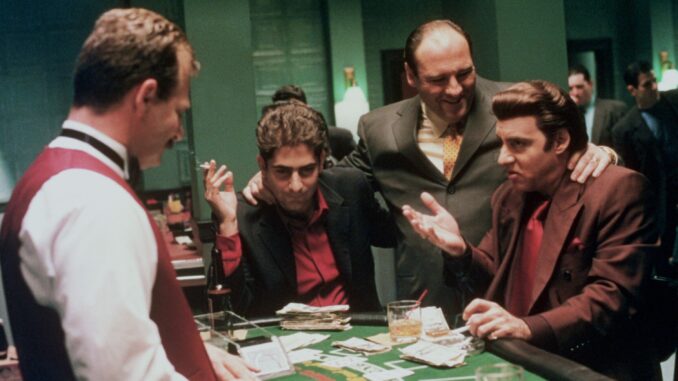
Introduction: The Mystery of The Sopranos Finale
Since its finale aired in 2007, The Sopranos has become a cultural touchstone, sparking endless debates about its ambiguous conclusion. The iconic final scene—set in a diner and ending with a sudden cut to black—left fans reeling and speculating about Tony Soprano’s fate. Was he killed? Did he live? David Chase, the show’s creator, has often teased fans with cryptic comments, but recent revelations shed new light on this ongoing mystery.
A Look Back at the Finale: What Happens in the Diner?
In the final moments of The Sopranos, we find Tony (James Gandolfini) sitting in a booth at Holsten’s diner, flanked by his family. As he waits for Meadow (Jamie-Lynn Sigler) to arrive, tension builds with the arrival of various patrons. The camera captures seemingly mundane moments—a man entering the diner, a mysterious figure at the counter—but then, just as the music swells and Tony looks up, the screen abruptly cuts to black. This unexpected ending left audiences gasping, and the question on everyone’s lips: What does it all mean?
Chase’s Reflection on the Ending
In a recent documentary, Wise Guy: David Chase and The Sopranos, Chase discusses this scene in detail, revealing layers of meaning that have gone largely unnoticed. He hints that he had deeper intentions behind the cut to black, referencing a pivotal moment from season three that might provide clues to Tony’s fate.
The Robert Frost Connection: A Deeper Symbolism
Chase recalls a scene from season three, episode two, titled “Proshai, Livushka,” where Meadow helps her brother AJ (Robert Iler) with his homework. In this scene, they analyze Robert Frost’s poem, “Stopping by Woods on a Snowy Evening.” This seemingly innocent moment becomes crucial when Meadow discusses the symbolism of snow.
“Hello? Cold, endless white, endless nothing. Death!” she declares. Chase emphasizes that this conversation lingered in his mind as he crafted the series finale. The connection to snow as a symbol of death serves as a haunting reminder of the constant threat that looms over Tony’s life as a mob boss.
Tony’s Fate: What Did Chase Really Mean?
Chase’s comments have sparked debate among fans. Is he confirming that Tony dies in the diner? Not necessarily. While he has referred to the ending as a “death scene,” he also insists that its purpose was to illustrate the unpredictability of life. As Chase explained, “He could have been whacked in the diner. We all could be whacked in a diner.”
This notion of life’s fragility permeates the series. Throughout the show, characters frequently face the consequences of their actions, and the finale serves as a poignant reminder that danger is ever-present. The ending may not provide a definitive answer about Tony’s fate, but it encapsulates the uncertainty that defines his existence.
The Role of Ambiguity in The Sopranos
One of the defining characteristics of The Sopranos is its refusal to offer neat conclusions. The series consistently blurs the lines between good and evil, leaving viewers grappling with moral ambiguity. By crafting an ending that avoids a clear resolution, Chase encourages fans to reflect on the themes of the show.
The ambiguity isn’t merely a narrative choice; it’s an invitation for viewers to engage with the material in a deeper way. Whether Tony is alive or dead becomes less significant than what his life represents: the perpetual tension between family, loyalty, and the violent world of organized crime.
Fan Theories and Interpretations: What Do We Think?
Fans have developed countless theories to explain the ending. Some believe the abrupt cut signifies Tony’s death, while others argue it’s a commentary on the unpredictability of life. Social media platforms and forums are rife with speculation, showcasing the passionate engagement the show continues to inspire.
A prevalent theory suggests that the cut to black represents the moment Tony’s life could end at any moment. The finality of the cut mirrors the unpredictability faced by those living a life of crime. It’s an unsettling reminder that any mundane moment can quickly turn lethal.
Chase’s Elusiveness: Why He Avoids Definitive Answers
David Chase has repeatedly avoided giving a clear answer about Tony’s fate, often saying it’s meant to be left open to interpretation. This elusiveness has become part of the show’s legacy. Chase knows that the discussions sparked by the ending keep The Sopranos alive in the cultural zeitgeist. By refusing to clarify, he allows fans to form their own conclusions, fostering a sense of community and shared exploration.
In many ways, Chase’s refusal to confirm or deny Tony’s death reflects the complexity of the character himself. Tony Soprano is a multi-faceted figure, embodying both charm and danger. His fate is emblematic of the show’s central themes, making any clear resolution feel unsatisfying in a world where life—and death—are seldom black and white.
Conclusion: The Enduring Legacy of The Sopranos
As we continue to dissect the finale of The Sopranos, it’s clear that its legacy endures not only because of its storytelling but also due to its thought-provoking ambiguity. David Chase’s recent reflections remind us that The Sopranos isn’t just a story about a mobster; it’s a meditation on the complexities of life and death. Whether Tony Soprano met a violent end in that diner or walked away to face another day, the true power of the finale lies in its ability to provoke discussion, reflection, and connection among viewers.
FAQs
Q: Did David Chase confirm Tony’s death?
A: Not definitively. Chase has referenced the ending as a “death scene” but emphasizes the ambiguity, suggesting it reflects the unpredictability of life rather than providing a clear answer about Tony’s fate.
